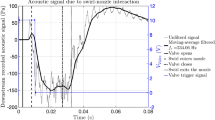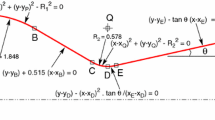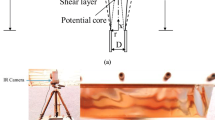Abstract
The effects of swirl on the rate of mass flow and on the velocity field in the throat region of axi-symmetric nozzles are studied analytically and experimentally. In the analytical phase, methods are developed for treating either the direct or the inverse problem for flow in de Lavai and annular nozzles, taking account of either weak or strong swirl. The experiments were performed in an annular nozzle, with swirl being imparted to the flow by adjustable vanes situated upstream of the test section.
The analytical results facilitated an examination of the effects of swirl strength, distribution of swirl, and nozzle geometry. The rate of mass flow was found to decrease with increasing swirl strength. The mass flow results were well correlated by a swirl strength parameter evaluated at the throat, with swirl type and geometry being of secondary importance. Another effect of swirl was to shift the sonic line upstream of the geometric nozzle throat. The experimentally determined mass flow results were in agreement with the analytical predictions. Also, all of the qualitative characteristics of the local flow field measurements were reproduced by the analytical results.
Zusammenfassung
Der Einfluß einer Wirbelkomponente auf den Massenfluß und das Geschwindigkeitsfeld in dem Gebiet um den engsten Querschnitt von zylindersymmetrischen Düsen wird analytisch und experimentell untersucht. In dem analytischen Teil werden Methoden zur Behandlung sowohl des direkten als auch des inversen Problems der Strömung in Laval- und ringförmigen Düsen entwickelt, für entweder eine schwache, oder eine starke Wirbelkomponente. Die Experimente sind mit einer ringförmigen Düse durchgeführt worden, wobei die Rotation der Strömung durch verstellbare Flügel stromaufwärts der Versuchskammer erzeugt worden ist.
Die analytischen Ergebnisse erleichtern die Untersuchungen des Einflusses von Wirbelstärke, Verteilung des Wirbels und der Düsengeometrie. Die Ergebnisse zeigen, daß der Massenfluß abnimmt mit zunehmender Stärke der Wirbelkomponente. Die resultierenden Werte für den Massenfluß können gut durch einen Wirbelstärkenparameter korreliert werden, der für den engsten Querschnitt der Düse entwickelt wird. Die Art des Wirbels und die Düsengeometrie ist von untergeordneter Bedeutung. Ein weiterer Effekt der Wirbelkomponente ist die Verschiebung der Fläche, wo die Strömung die Machzahl 1 erreicht, in eine Position stromaufwärts der Stelle des geringsten Querschnitts. Die experimentell bestimmten Massenflüsse stimmen mit den theoretisch vorhergesagten überein. Ebenso sind alle qualitativen Merkmale der lokalen Strömungsfeldmessungen durch die analytischen Resultate reproduziert worden.
Similar content being viewed by others
Abbreviations
- A:
-
cross sectional area
- a:
-
sound speed
- a* :
-
critical speed
- H2 :
-
ratio,ρ *a*/pq
- h:
-
enthalpy
- h0 :
-
stagnation enthalpy
- M* :
-
dimensionless velocity magnitude, (ũ2 + v2 + w2)1/2/a*
- m:
-
ratio of mass flow with and without swirl
- \(\widehat{\dot m}\) :
-
mass flow parameter, Eq. (61)
- P:
-
proportionality function, Eq. (48)
- p:
-
static pressure
- q:
-
velocity vector in r, z plane, Eq. (50)
- R:
-
radius of curvature of nozzle wall at geometrical throat
- R:
-
dimensionless radius of curvature, Eq. (10)
- r, rw, r* :
-
radial coordinate, wall radius, throat radius
- r, rw :
-
dimensionless radial coordinate and wall radius, Eq. (10)
- S:
-
swirl parameter, Eq. (60)
- Ŝ:
-
swirl parameter, Eq. (61)
- s:
-
entropy
- T:
-
absolute temperature
- ũ, v, w:
-
velocity components in radial, tangential, and axial directions
- u, v, w:
-
dimensionless velocity components, Eq. (10)
- x:
-
stream function, Eq. (47)
- z:
-
axial coordinate
- z:
-
dimensionless axial coordinate, Eq. (10)
- γ :
-
ratio of specific heats
- η, ξ :
-
scaled coordinates, Eq. (51)
- 'S :
-
generalized velocity potential, Eq. (48)
- ρ :
-
density
- ρ * :
-
density corresponding to a*
- ψ :
-
stream function
- R:
-
reference streamline
References
Boerner, C. J.: Compressible Swirling Flow through Nozzles. Ph.D. Thesis, Dec. 1970, University of Minnesotta, Minneapolis, Minn.
Norton, D. J., Farquhar, B. W., Hoffman, J. B.: An Analytical Investigation of the Fluid Mechanics of Rotating Flows in Rocket Motors. TM-67-7, Oct. 1967, Jet Propulsion Center, Purdue University, Lafayette, Ind.
Norton, D. J., Farquhar, B. W., Hoffman, J. B.: An Analytical and Experimental Investigation of Swirling Flow in Nozzles. F-67-9, Oct. 1967, Jet Propulsion Center, Purdue University, Lafayette, Ind.
Lewellen, W. S., Burns, W. J., Strickland, H. J.: Transonic Swirling Flow. AIAA Journal 7, No. 7 (1969) 1290/1297.
King, W. S.: On Swirling Nozzle Flows. Journal of Spacecraft and Rockets 4, No. 10 (1967) 1404/1405.
Manda, L.: Spin Effect on Rocket Nozzle Performance. Journal of Spacecraft and Rockets 3, No. 12 (1966) 1695/1696.
King, M. K.: Comment on Spin Effect on Rocket Nozzle Performance. Journal of Spacecraft and Rockets 3, No. 12 (1966) 1812/1813.
Bastress, E. K.: Interior Ballistics of Spinning Solid Propellant Rockets. Journal of Spacecraft and Rockets 2, No. 3 (1965) 455/457.
Hall, M. G.: The Structure of Concentrated Vortex Cores. In Progress in Aeronautical Sciences, D. Küchemann, ed., Vol. 7, Pergamon Press, Oxford (1966) 53/110.
Mager, A.: Approximate Solution of Isentropic Swirling Flow through a Nozzle. ARS Journal 31, No. 8 (1961) 1140/1148.
Binnie, A. M.: The Passage of a Perfect Fluid through a Critical Cross Section or Throat. Proceedings of the Royal Society of London, Vol. A197 (1949) 545/555.
Farquhar, B. W.: An Experimental Investigation of Swirling Flow in Nozzles. Ph.D. Thesis, June 1968, Purdue University, Lafayette, Ind.
Kliegel, J. R., and Quan, V.: Convergent-Divergent Nozzle Flows. AIAA Journal 6, No. 9 (1968) 1728/1754.
Hopkins, D. F., Hill, D. E.: Effect of Small Radius of Curvature on Transonic Flow in Axisymmetric Nozzles. AIAA Journal 4, No. 8 (1966) 1337/1343.
Hopkins, D. F., Hill, D. E.: Transonic Flow in Unconventional Nozzles. AIAA Journal 6, No. 5 (1968) 838/842.
Rouse, H., Hassan, M. M.: Cavitation-free Inlets and Contractions. Mechanical Engineering 71 (1949) 213/216.
Author information
Authors and Affiliations
Additional information
Publication from the Heat Transfer Laboratory, University of Minnesota, Minneapolis, Minnesota.
Rights and permissions
About this article
Cite this article
Boerner, C.J., Sparrow, E.M. & Scott, C.J. Compressible swirling flow through convergent-divergent nozzles. Warme- und Stoffubertragung 5, 101–115 (1972). https://doi.org/10.1007/BF01438411
Received:
Issue Date:
DOI: https://doi.org/10.1007/BF01438411




